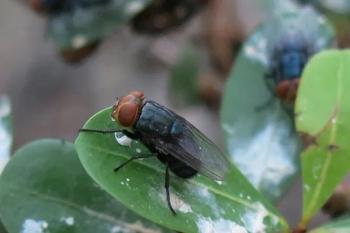
ClinQuiz: Ectoparasites
Test your knowledge of external parasites with this short quiz.
ClinQuiz
Figure 1. The brown dog tick, Rhipicephalus sanguineus, can be identified by its solid brown color, relatively short mouthparts, and laterally projected basis capituli. 1) The brown dog tick, Rhipicephalus sanguineus, is unusual in that it survives inside homes and kennels, feeding on dogs in all stages of its life cycle and, thus, is frequently found on dogs across the United States. It can be identified by its solid-brown color, relatively short mouthparts, and laterally projected basis capituli (Figure 1). Historically considered to have a strict preference for dogs, this tick was recently implicated in an outbreak involving the transmission of which of the following agents to dogs and people?
Figure 2. A parasite removed from a subcutaneous cyst on the neck of a cat.2) The parasite shown in Figure 2 was removed from a subcutaneous cyst on the neck of a 3-month-old barn cat. Although the prognosis after successful removal of this parasite is good, occasionally these parasites will migrate aberrantly in kittens and older cats, resulting in which clinical presentation?
Figure 3A. A tick removed from a dog that presented in southern Missouri with fever, lethargy, and thrombocytopenia.Figure 3B. An organism found in a neutrophil on a blood smear (modified Wright's stain [Diff-Quik-Dade Behring]; 1,000X).
3) A 5-year-old mixed-breed dog from southern Missouri was presented for evaluation in early June with numerous ticks attached (Figure 3A). The dog was febrile and depressed. A complete blood count showed a normocytic, normochromic, nonregenerative anemia and mild thrombocytopenia. A blood smear revealed the organisms seen in Figure 3B. What is the most appropriate treatment?
Figure 4. An arthropod submitted from an infested home in which both the dog and client were receiving numerous bites. 4) A client with a 4-year-old spayed female American Staffordshire terrier calls your office to report a tick infestation in his home. He describes bites on both himself and the dog, especially at night (the dog sleeps with him). Later that day, he brings in the organism shown in Figure 4 and requests a tick-control product to eliminate the infestation. What organism is this?
Figure 5. An organism found on a skin scrape of a hyperkeratotic lesion on extremely pruritic dog (unstained; 400X).5) The organism seen in Figure 5 was found on a skin scrape from a hyperkeratotic patch on the elbow of an extremely pruritic 6-year-old mixed-breed dog. Which of the following products is labeled in the United States to provide safe, effective treatment of infestations with this parasite?
Newsletter
From exam room tips to practice management insights, get trusted veterinary news delivered straight to your inbox—subscribe to dvm360.





